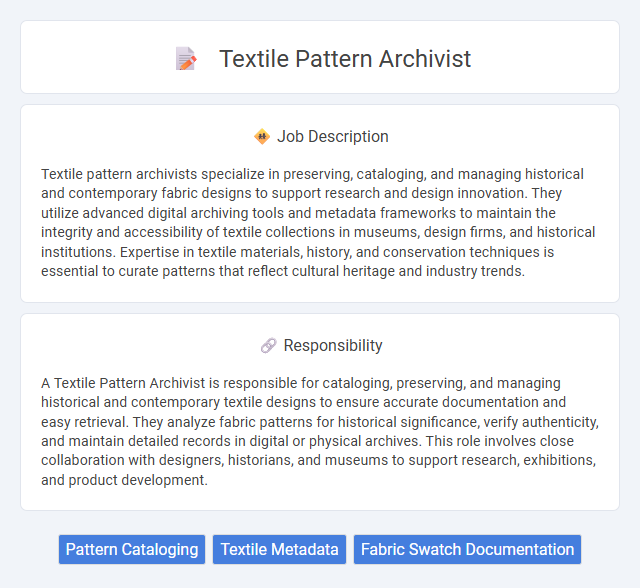
Textile pattern archivists specialize in preserving, cataloging, and managing historical and contemporary fabric designs to support research and design innovation. They utilize advanced digital archiving tools and metadata frameworks to maintain the integrity and accessibility of textile collections in museums, design firms, and historical institutions. Expertise in textile materials, history, and conservation techniques is essential to curate patterns that reflect cultural heritage and industry trends.
Individuals who enjoy detail-oriented tasks and have a passion for preserving historical textiles are likely to be well-suited for a Textile Pattern Archivist role. Those with strong organizational skills and patience may find the meticulous nature of cataloging and maintaining delicate fabric samples fitting for their abilities. However, candidates who prefer fast-paced environments or less repetitive work might find this position less compatible with their preferences.
Qualification
A Textile Pattern Archivist typically requires a degree in textile design, art history, or museum studies, with specialized knowledge of fabric construction, pattern analysis, and historical textile techniques. Proficiency in digital archiving tools, database management, and conservation methods is essential to preserve and catalog textile collections accurately. Experience in research, attention to detail, and strong organizational skills are critical for managing extensive pattern archives within museums, fashion houses, or design firms.
Responsibility
A Textile Pattern Archivist is responsible for cataloging, preserving, and managing historical and contemporary textile designs to ensure accurate documentation and easy retrieval. They analyze fabric patterns for historical significance, verify authenticity, and maintain detailed records in digital or physical archives. This role involves close collaboration with designers, historians, and museums to support research, exhibitions, and product development.
Benefit
A textile pattern archivist likely benefits from preserving valuable historical designs, contributing to cultural heritage and fashion innovation. They probably gain access to rare and unique textile collections, supporting research and creative development. The role may offer opportunities for collaboration with designers, museums, and educational institutions, enhancing professional growth.
Challenge
Textile pattern archivist roles likely involve the challenge of meticulously preserving and categorizing delicate historical fabrics, which requires a keen eye for detail and deep knowledge of textile history. The position may demand navigating varying conditions of pattern degradation, making conservation and digital documentation complex and time-consuming tasks. There is probably a constant need to balance accessibility for researchers with stringent preservation protocols to protect the integrity of the collections.
Career Advancement
A textile pattern archivist manages and preserves historical fabric designs, ensuring accurate cataloging and accessibility for research and design innovation. Mastery of digital archiving tools and collaboration with fashion historians significantly enhance opportunities for leadership roles in museums or design firms. Advancing to senior archivist or curator positions often requires specialized knowledge in textile conservation and a strong portfolio of published research.
Key Terms
Pattern Cataloging
Pattern cataloging in textile pattern archivist roles involves systematically organizing and documenting historic and contemporary textile designs to facilitate research and preservation. Experts employ detailed metadata standards, including design motifs, color schemes, fabric types, and production techniques, ensuring accurate classification and easy retrieval. Mastery of digital archiving tools and textile history enhances the accuracy and accessibility of pattern databases for museums, designers, and scholars.
Textile Metadata
Textile pattern archivists specialize in cataloging and preserving intricate details of textile designs, ensuring accurate textile metadata is captured for historical and research purposes. They utilize standardized vocabularies and digital databases to enhance searchability and data interoperability within textile collections. Mastery in metadata schemas such as Dublin Core and CIDOC CRM supports their role in maintaining comprehensive and accessible textile pattern archives.
Fabric Swatch Documentation
Fabric swatch documentation is crucial for textile pattern archivists, ensuring accurate cataloging of texture, color, and weave details for future reference and design inspiration. Detailed digital records include high-resolution images, fiber composition, production techniques, and historical context, facilitating efficient retrieval and preservation of fabric samples. This meticulous documentation supports design innovation, quality control, and academic research within the textile industry.
 kuljobs.com
kuljobs.com